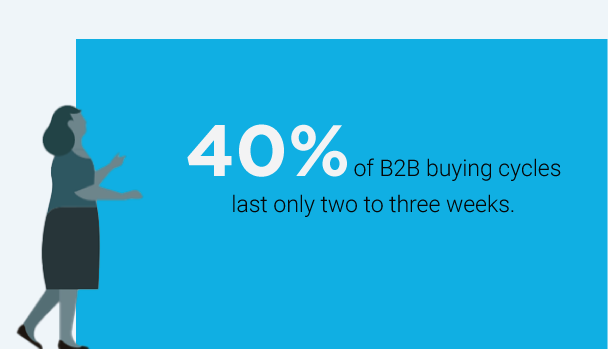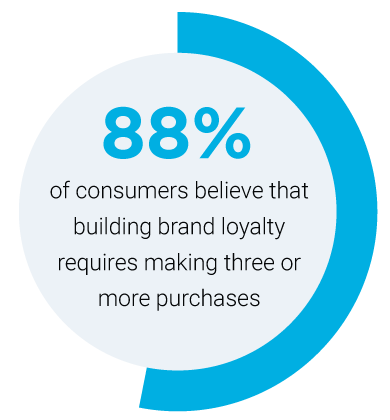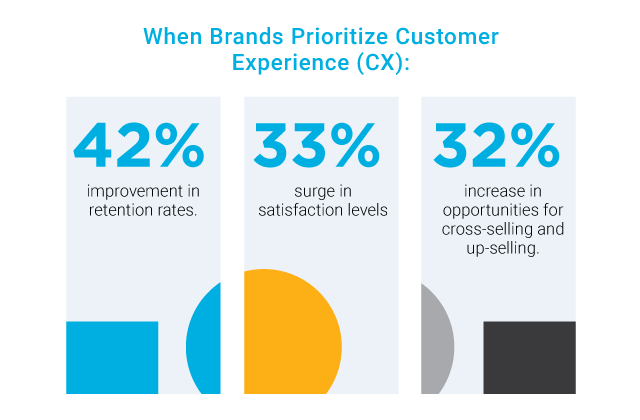In today’s ever-evolving tech marketing landscape, traditional concepts like B2B brand awareness and demand generation are undergoing significant transformations. The emergence of brand to demand marketing represents a paradigm shift, highlighting the deep-seated connection between brand building, visibility, and consumer interest. Gone are the days of treating these elements as separate entities. Nowadays a strong brand not only fuels consumer excitement but also emerges as a result of it.
By integrating the potency of branding with demand creation, B2B brands can attract customers and cultivate loyal brand advocates who actively spread the word. As competition continues, it’s essential to grasp and utilize the interconnection between branding and demand generation to ensure long-term success. This article aims to delve into this marketing concept, offering actionable insights to assist brands in forging deeper connections with their target audience and driving sales.
“Demand for your business is driven by the quality of your reputation. Live and breathe your values to maintain control of your brand reputation.” – Stacey Kehoe.
Understanding Brand to Demand
Significance of brand to demand in today’s market
With B2B tech marketing evolving at a rapid pace, the brand to demand marketing strategy has emerged as a cornerstone for marketers. It’s no longer about pushing a product; instead, it involves cultivating a positive brand identity and nurturing robust relationships with buyers throughout the B2B buying journey. As B2B buying cycles become increasingly complex and lengthy, marketing teams find it challenging to engage with their target audience effectively. Consequently, marketing assumes a pivotal role in shaping the brand narrative and instilling trust in potential buyers throughout the B2B buying process. However, a common pitfall is prioritizing demand-focused activities at the expense of brand-building efforts, which underscores the importance of integrating brand to demand strategies in B2B marketing.

Brand to demand strategies play a critical role in influencing consumer willingness to make purchases. The research underscores the mediating effect of the marketing mix, emphasizing the importance of aligning brand messaging with consumer attitudes and behaviors. Understanding demand marketing strategies for lead generation enables companies to optimize their marketing plans and effectively capture a larger market share. However, solely prioritizing your brand-building strategy may hinder immediate growth and ROI. Achieving a balanced approach entails leveraging data to identify early-stage accounts, personalizing content and messaging, and deploying a multi-channel campaign, along with a brand-building campaign. This holistic brand to demand marketing is essential for establishing awareness, building trust, and driving sustainable growth in today’s competitive landscape.
The brand and demand mix
While demand gen primarily aims to fill the sales pipeline, it inherently crafts a narrative, establishes an emotional connection, and fosters brand-building strategy and affinity among potential customers. This entails aligning every facet of the demand process with the perceptions and purchasing behaviors of buyers, thus highlighting the inseparable connection between demand and brand. This synthesis between lead generation and brand impact is where the true magic of marketing happens.
A strong brand impact cultivated through demand-generation efforts lays the groundwork for sustained growth, fostering customer loyalty and advocacy beyond a one-time purchase. Metrics in demand gen now encompass both quantitative indicators like leads and conversions and qualitative measures such as brand sentiment, customer satisfaction, and loyalty, collectively demonstrating the comprehensive impact of demand gen efforts on the brand. Ultimately, brand building and demand creation are not opposing forces but two sides of the same coin. They work hand in hand to create a harmonious marketing strategy that drives growth, enhances customer loyalty, and fosters long-term business success in today’s competitive landscape.
Impact of branding on consumer behavior and purchasing decisions
Strong branding profoundly influences consumer behavior and purchasing decisions in several ways. Firstly, branding shapes consumer perception by establishing a connection between the brand message and the consumer’s self-image. When consumers resonate with a brand’s values and message that helps overcome their challenges, they are more likely to develop brand loyalty in the long run. Secondly, branding influences purchasing decisions through peer influence. Brand building leverages peer influence to sway purchasing decisions, as consumers often rely on recommendations from colleagues or friends, hence trusting brands that their social circle endorses. This positive peer influence enhances brand credibility and reinforces consumer trust, leading to increased sales and brand loyalty. Thirdly, branding profoundly impacts consumer behavior and purchasing decisions by creating unique multisensory experiences that emotionally resonate with consumers. Through sensory branding, brands can provide novelty, excitement, and value, fostering emotional connections and influencing consumer choices, ultimately leading to stronger brand loyalty and equity.
The Connection Between Brand and Demand
Explore the relationship between a strong brand and increased demand
The conventional approach to brand building comprises two fundamental components. Firstly, it concentrates on identifying the target consumer and crafting a distinct identity for products and services that sets them apart from competitors in consumers’ minds. This involves integrating both tangible and intangible elements to establish a cohesive brand image. Secondly, brand value emerges as the synthesis of various factors, including brand identity, brand image, brand positioning, and B2B brand awareness, which are influenced by the actions of marketing managers. Traditionally and from contemporary perspectives, brands have been viewed through the lens of the customer-brand relationship. Initially, emphasis was placed on understanding the interplay between customers and brand attributes in shaping product perceptions. The relationship between strong branding and increased demand in B2B marketing is significant and multifaceted.

How do B2B companies leverage their brand to drive demand?
B2B companies employ their brand strength to stimulate demand, employing strategic marketing tactics and partnerships. Targeted strategies such as intent and account-based marketing ensure efficient audience engagement. Through the incorporation of intent data and personalized content, the best brand marketing campaigns achieve heightened effectiveness and superior outcomes. Strategic partnerships are pivotal in enabling the creation of integrated solutions and compelling narratives tailored to the unique needs of the B2B buying process. Collaborating with multiple partners amplifies messaging, expands outreach, and enhances conversions, ultimately bolstering the brand to demand approach in B2B marketing.
The dynamics of demand gen extend beyond marketing alone, requiring seamless integration with sales processes, a facet often overlooked in organizations. As buyers gain access to more information through the internet, social media platforms, and other digital channels, their purchasing approach has become increasingly sophisticated and complex. Instead of relying solely on marketers for information, they are actively seeking product details independently and exerting greater control over their buyer journey. This customer-centric approach facilitates better engagement by effectively addressing consumer concerns and behaviors. Streamlining the best brand marketing campaigns with ready-to-use offers enhances marketers’ efficiency in sales conversations, thereby amplifying their impact on consumers.
Additionally, B2B enterprises must employ follow-up strategies to boost conversions, aligning marketing and sales efforts. By customizing messages and equipping sales and marketing teams with insights, marketers can effectively nurture leads through the sales pipeline. This synchronization of marketing and sales efforts optimizes lead management, ultimately enhancing overall demand gen outcomes.
Explain how brand loyalty & equity contribute to demand generation
Strong brand building and image foster trust, increasing the likelihood of customers choosing your brand over competitors.
Reduced acquisition costs: Loyal customers are like family. They know and trust your brand, making repeat purchases a natural choice. This reduces the resources needed to constantly acquire new customers, saving on marketing and sales efforts.
Increased customer lifetime value: Loyal customers don’t just come back; they tend to spend more each time. This naturally opens up avenues for upselling and cross-selling, thus boosting your revenue potential.
 Your brand advocates: Happy customers become your biggest fans. Positive reviews, recommendations, and social media buzz can attract new customers, who are influenced by the positive experiences of others.
Your brand advocates: Happy customers become your biggest fans. Positive reviews, recommendations, and social media buzz can attract new customers, who are influenced by the positive experiences of others.
Price with confidence: A strong brand commands respect. When customers trust your brand’s quality, service, value, and overall experience, they’re willing to pay a slight premium compared to competitors. This pricing power allows you to maintain healthy profit margins.
Strategies for Brand Building to Drive Demand Generation
Consistent brand messaging across all channels
A consistent message across sales and marketing channels solidifies your brand identity in your audience’s mind. It clarifies your company’s purpose, solutions, and offerings, fostering credibility and trust. Trust boosts engagement, as familiar messaging builds rapport with your audience across touchpoints. The customer touchpoints encompass written proposals, business conversations, customer service interactions, website content, and marketing materials. Consistent messaging enhances lead generation and sales by attracting better-qualified leads and facilitating business expansion and scaling efforts. For example, Cisco humanizes its brand and simplifies technology through storytelling. Emotionally resonant campaigns and social responsibility initiatives like disaster relief with Mercy Corps showcase their impact across channels.
Building emotional connections with consumers
Cultivating an emotional connection with consumers is a potent driver of demand. By tapping into human emotions, businesses can influence the decision-making process profoundly. Fear, curiosity, trust, and joy are among the most leveraged emotions to engage the audience effectively. Joy forges a lasting connection; for example, Slack fosters emotional connections through simplified communication and seamless integration with popular tools, humanizing its brand on Instagram. They leverage social proof and compelling narratives to solidify bonds. By measuring emotional impact ethically and adapting to cultural nuances, businesses can foster brand loyalty and social responsibility, ensuring sustained success in an ever-evolving digital landscape.
Leveraging storytelling to communicate brand values
Storytelling communicates brand value by evoking emotional responses, fostering connections, and differentiating brands in a crowded market. The key aspect here is consistency. For example, Asana’s website cut through the content clutter and was super clear on which problems and challenges they could solve for their customers. By incorporating relatable situations, characters, and conflict resolution, brands can create memorable experiences that inspire action and loyalty. Authenticity, simplicity, and visual storytelling further enhance brand stories, ensuring they resonate with audiences and drive meaningful engagement and brand loyalty.
Providing exceptional customer experiences
Exceptional customer experiences (CX) bolster brand reputation, loyalty, and demand. When brands prioritize CX, they create positive emotional connections with customers, fostering trust and advocacy. Satisfied customers are more likely to become repeat buyers and recommend the brand to others, amplifying demand. CX excellence differentiates brands in competitive markets, elevating perceived value. Customer experience (CX) improves retention rates, increases profitability, and reduces churn, Brands not only expand their customer base but also cultivate loyal advocates. These advocates, in turn, amplify brand sentiments both online and offline, leveraging the transformative power of the internet. Brands delivering seamless, personalized experiences cater to individual needs, enhancing satisfaction and loyalty. For example, Dropbox’s sleek design, vibrant colors, and user-friendly interface deliver exceptional collaboration experiences. Ultimately, exceptional CX cultivates a strong brand identity, resonating with consumers and fueling demand through word-of-mouth referrals and positive reviews.

Utilizing social proof and influencer marketing
Utilizing social proof and influencer marketing can significantly enhance brand credibility and drive consumer engagement. Social proof leverages the power of testimonials, reviews, and user-generated content to showcase the positive experiences of existing customers, influencing potential buyers’ decisions. Meanwhile, influencer marketing involves collaborating with individuals who have a substantial following and influence in specific niches to promote products or services. In influencer marketing, brands empower influencers to share brand information on social media, aligning with traditional communication models. Influencers’ authentic endorsements resonate with skeptical consumers more effectively than traditional marketing tactics. By associating brands with trusted individuals, influencer marketing can expand reach and credibility among target audiences. Together, these strategies create a network of trust and authenticity, fostering stronger connections with consumers and driving conversion rates.
Measuring the Brand to Demand Success
Brand Awareness
Website traffic: This metric acts as a gauge of general brand interest. Analyzing both organic traffic (driven by search engines) and traffic stemming from the best brand marketing campaigns provides a clearer picture of improved brand visibility.
Social media engagement: Social media platforms offer a valuable window into real-time customer interaction. High engagement indicates brand recognition and potential customer interest, suggesting that your brand is resonating with your target audience.
Customer Engagement
Conversion rates: Conversion rates measure the percentage of individuals who take a desired action, indicating a deeper level of interest and potential progression toward becoming a customer.
Marketing qualified leads (MQLs): These are prospects who have engaged with your marketing content. Engaging these prospects further through lead nurturing can move those prospects further down the funnel.
Conversion Metrics
Sales qualified leads (SQLs): MQLs who have been further nurtured and deemed ready for the sales team are classified as SQLs. These leads demonstrated interest in becoming paying customers by taking certain actions.
Customer lifetime value (CLV): This metric goes beyond immediate sales. It estimates the total revenue a customer is expected to generate throughout their relationship with the brand. Focusing on increasing LTV is crucial for sustainable business growth.
Brand Loyalty and Advocacy
Brand advocacy: Tracking mentions and recommendations from satisfied customers reflects brand loyalty and trust. Positive word-of-mouth marketing through brand advocates is a powerful tool, amplifying B2B brand awareness and influencing purchasing decisions.
Brand sentiment analysis: social media listening and online reviews provide valuable insights into customer perception. Analyzing the sentiment behind brand mentions helps businesses understand how their brand is being perceived and address any negative feedback promptly.
Challenges and Pitfalls to Brand to Demand Success
Not engaging customers enough
Engaging customers effectively becomes daunting when dealing with diverse customer segments and their varied experiences throughout the B2B buying process. To address this challenge, businesses can leverage intent data to gain insights into the behaviors of decision-makers within each customer segment. By understanding how these buyers approach problem-solving and what factors influence their purchasing decisions, businesses can tailor their marketing efforts more effectively. Moreover, an advertisement emotionally influences 70% of potential buyers, thereby boosting their chances of purchasing the product.

Lead source management
Managing multiple lead sources, including paid and owned channels, can be time-consuming and challenging to track effectively. Implementing systems that centralize lead source management and automate top-of-funnel activities can streamline the lead management process. Utilizing analytics tools to track and measure the effectiveness of each lead source further enhances decision-making and resource allocation.
Keeping the customer’s perspective in mind
Maintaining a customer-focused approach throughout the demand generation process requires a deep understanding of the B2B buying journey, pain points, and preferences. Without this insight, businesses may struggle to create content and messaging that resonates with their target audience effectively. Structuring content, marketing, and sales strategies around a thorough understanding of consumer personas and the B2B buying journey is essential for addressing this challenge.
Measuring brand impact
Measuring the long-term effects of brand marketing efforts on customer behavior, loyalty, and advocacy can be challenging due to the qualitative nature of brand impact metrics. Businesses can leverage both quantitative and qualitative data to measure brand impact effectively. Utilizing tools and methods such as surveys, social listening, and brand sentiment analysis can provide valuable insights into customer perceptions and attitudes toward the brand.
In conclusion, the brand to demand strategy for business growth has emerged as a vital approach for businesses aiming to establish a strong brand presence while driving demand and conversions. By understanding demand marketing strategies for lead generation, comprehending the customer buying journey for targeted marketing, and recognizing the intricate connection between brand building, B2B brand awareness, and demand generation, companies can create holistic marketing strategies. Exploring examples of successful brand to demand in B2B marketing, these strategies can resonate with their audience, foster brand loyalty, and drive sustainable growth. Furthermore, by understanding the customer buying journey for targeted marketing, businesses can enhance their brand to demand efforts by utilizing data-driven insights, customization, and multi-channel campaigns, effectively captivating customers and boosting sales in today’s competitive market landscape. As organizations continue to navigate evolving consumer behaviors and market trends, embracing brand to demand marketing will be essential for staying ahead of the curve and achieving long-term success.




